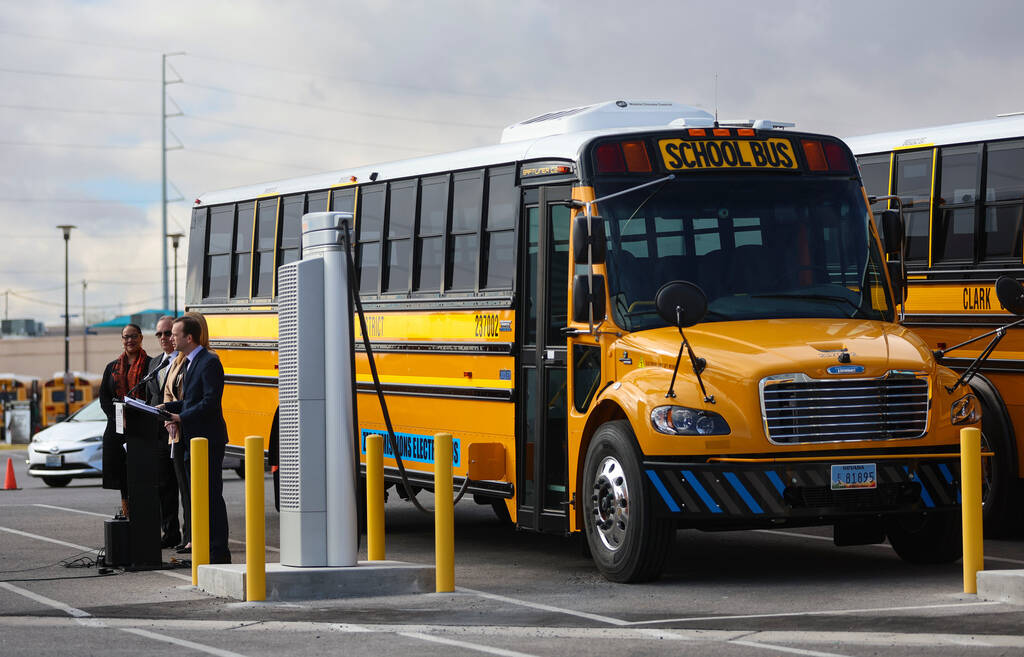Tired of diesel fumes, Las Vegas mom pushes for electric school buses
Areli Sanchez’s daughter, Aida, used to be one of 20 million American kids who ride a diesel bus to school each day.
Aida has asthma. When she was little, she complained about the smell and cloud of fumes on her twice-daily trip.
“When she would come home from school or be on the bus, she got headaches and sick to her stomach. She said, ‘Mami, I don’t feel well, I feel dizzy,’” Sanchez said in Spanish from Las Vegas. Aida missed classes a lot when her asthma was bad. Research shows diesel exhaust exposure can cause students to miss school and affect learning.
She was admitted to the hospital for an asthma attack in second grade, and after that Sanchez began driving Aida to school.
Diesel exhaust from school buses potentially affects one-third of U.S. students, their parents and educators each day, according to federal data. It’s a known carcinogen plus it contains harmful nitrogen oxides, volatile gases and particles that exacerbate lung issues. It also contributes to global warming.
Most affected by these environmental and health issues are Black, Latino, Indigenous and lower-income communities, who often rely on buses to get to school and are also more likely to suffer from asthma than other students. Some of the biggest drivers for change are parents worried about their children.
For Areli Sanchez’ family in Las Vegas, things continued to deteriorate.
She felt like she had to stop working. “I didn’t know when we were going to get another call from school about another asthma attack,” she said.
A few years after her daughter started having problems, Sanchez saw the opportunity to get involved in the nascent movement for electric buses. They don’t smell. They aren’t noisy. They cost more up front, but cost less to run and can meaningfully reduce emissions, making them a climate change solution.
Now Sanchez has been making this case locally and beyond for four years, even taking a long diesel bus ride to the state capital, Carson City, to plead for funding from the legislature.
Recently she started to get some traction when the Clark County School District, her district, began to swap some of its buses for electric. These still make up only a fraction of the nearly 2,000 in the fleet, but she’s optimistic.
Some similar progress is taking place throughout the nation as a sense of urgency builds around worsening air quality and environmental injustice related to the warming climate.
Children are generally more harmed by air pollution than adults because their bodies are still developing, and because they breathe in more air per body size than adults do, said University of Michigan epidemiology and public health researcher Sara Adar, who studies the link between health and school buses.
“As they’re burning their fuel and as the engine is spinning, they often are releasing very, very small particles that can get deep into our lungs and cause havoc throughout the body,” Adar said.
Kids also can spend considerable time around idling buses, she noted, lengthening their exposure to something that can permanently damage their health. Research has highlighted poor air quality inside older diesel school buses, too.
“It’s this perpetual cycle of bad air quality,” said Lonnie Portis, a policy and advocacy manager for the activist group We Act for Environmental Justice in New York City. In hard-hit, or environmental justice neighborhoods, he said, “you’re removing at least some of that by putting electric school buses in the rotation.”
Some school districts have switched to newer versions of diesel buses, which are more efficient and produce less pollution, as one way to reduce students’ exposure. Others, especially in underfunded districts, keep their older, more polluting vehicles.
Much like Sanchez, Liz Hurtado, the mother of four children who ride the bus in Virginia Beach, Virginia, has spent years advocating for electric buses.
Her oldest daughter also got headaches riding a diesel bus, and she’d drive her to school when she could, she said.
Now a national field manager for the grassroots group Moms Clean Air Force and active in a program dedicated to protecting Latino children’s health, Hurtado appeals to school districts to buy electric buses. She schedules events for community members to see and drive electric vehicles, hosts webinars and meetings and teaches others how to reach out to legislators.
“Knowing all of the stressors and anxiety from climate change, and the fact that this is a huge burden for our children,” Hurtado said. “That places a burden on us, right?”
While an electric bus isn’t yet available to her, she still feels “really excited about the momentum.”
Federal money is now the leading source of funding for electric school buses, and prioritizes low-income, rural or Tribal communities, which advocates see as a huge win. Most electric school buses on the road today have landed in those areas, according to WRI.
“It means that we are putting the solution closest to the problem,” said Carolina Chacon, coalition manager for the Alliance for Electric School Buses, a group of nonprofit organizations that has been expanding.
Sanchez said Aida might not get to take advantage of the electric buses, since she is now 16.
“But other moms won’t have to worry like I did because of the fumes,” she said.

















